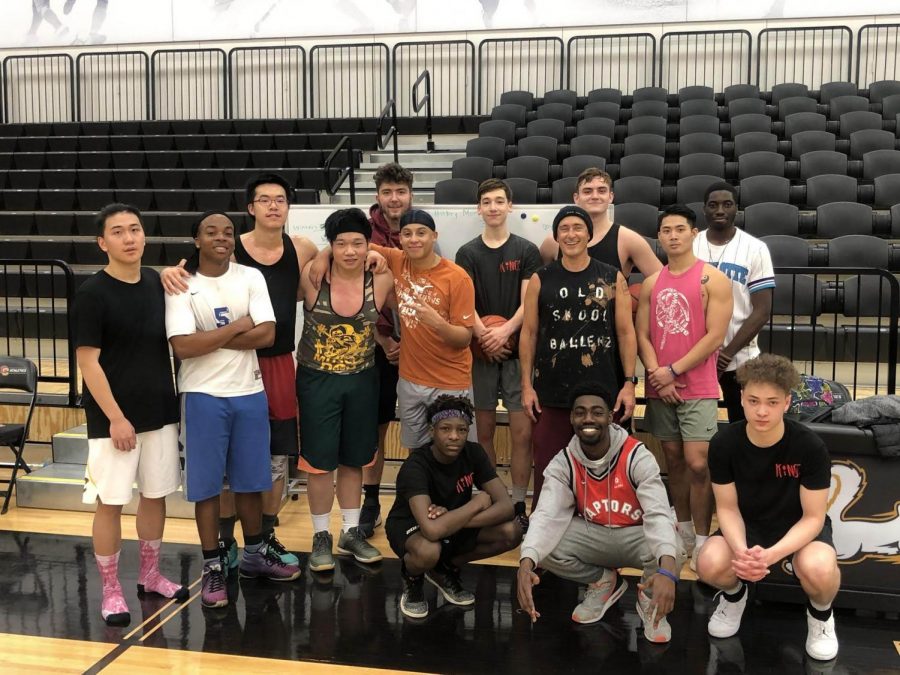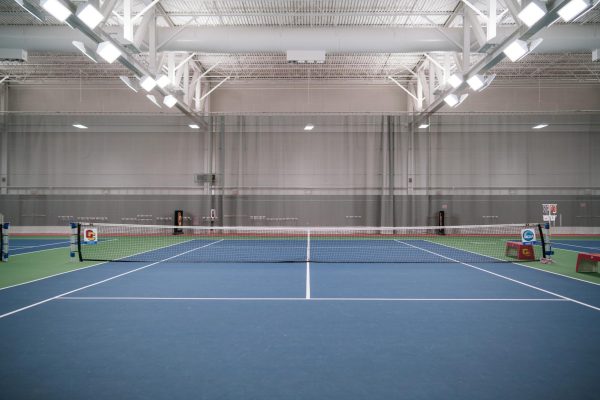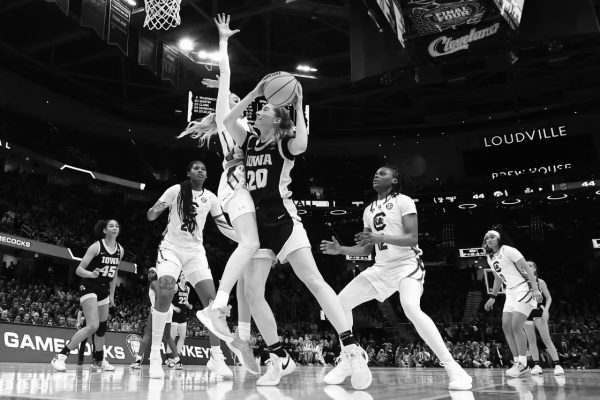Breaking Down Barriers Through Basketball
Students from Brotherhood Hall in the Afrikan Heritage House, the Black History Month Committee, and Professor of English Yago Colás hosted a 3-on-3 basketball tournament this past Sunday. Over 30 students and community members got together to celebrate Black History Month and enjoy an afternoon of pickup.
The son of a Presbyterian minister, Randy Miller arrived at Oberlin College in 1966 as a broad-shouldered, long-limbed first-year with a gentle demeanor and keen interest in music and art — as well as a knack for shooting baskets. His roommate and teammate, Al Wellington, was a hard-nosed kid with tremendous athletic ability who grew up in a low-income family of eight from a racially segregated community.
According to the book they co-wrote, Oberlin Fever, A Championship Spirit in Black and White, the two had very little in common. Miller was quiet and studious with plans to major in English, while Wellington had an air of confidence, frequently bragged about his looks, and was interested in Sociology. Miller’s family of five moved around a lot throughout his childhood, temporarily living in Ohio, Michigan, and New York, while Wellington resided in McDonald, Ohio, a town of 3,000 with only 19 Black households.
Despite all their differences, they had one thing in common: They loved playing basketball, and they understood that in order to help their team win games, they had to overcome barriers that said white and Black basketball players couldn’t become great teammates and friends. During their first year, they wrote and signed a covenant that said, “We solemnly pledge to work hard to improve our skills and conditioning and win the Ohio Athletic Conference Championship in basketball before we graduate from Oberlin.”
Three years later, on March 5, 1970, Miller and Wellington — the squad’s co-captains and lone seniors — were hoisted onto their teammates’ shoulders as a crowd of proud students and community members gathered in Tappan Square to celebrate the school’s first-ever OAC Championship in men’s basketball, one of the greatest moments in the Oberlin Athletics Department’s history to this day.
At the height of the Civil Rights Movement, Miller and Wellington put aside their racial differences and demonstrated that the basketball court is a place where people of different backgrounds and interests can work together to achieve greatness.
Half a century later, Candice Raynor, director and faculty-in-residence of the Afrikan Heritage House and chair of the Black History Month Committee, said she believes it’s important to include an athletics-related event in each year’s Black History Month celebration.
“In addition to the activists and academics we often celebrate during Black History Month, we also celebrate the athletes who are as important to the Black community as they are to the sports world,” Raynor said. “In addition to their success in sport, Black athletes have historically been considered heroes and activists, using their platforms to bring attention to issues facing the Black community.”
Last February, she and Professor of English Yago Colás hosted a panel titled “What’s My Name, Fool? Black Athletes, Activism, and the Media,” which featured University of Michigan Fab Five member Jimmy King, ESPN journalist and professor Kevin Blackistone, and professors Sarah Jackson and Louis Moore from Northeastern University and Grand Valley State University, respectively. The discussion centered around unemployed NFL quarterback Colin Kaepernick — who was blackballed by the NFL for beginning a movement by kneeling during the national anthem — and discussed the history of activism by Black athletes.
This past Sunday, students from Brotherhood Hall in the Afrikan Heritage House collaborated with the BHM Committee to organize a 3-on-3 basketball tournament, which attracted a diverse group of participants — including a team of three Oberlin students from China, a team of three residents of Afrikan Heritage House, and a team of Oberlin High School students from different racial and class backgrounds. Some participants had played varsity basketball in high school or at the collegiate level, and others were simply there to have fun.
Colás warned that it’s important to recognize that the African-American community is diverse and that sports have not played the same role — or even any role — for all African Americans.
“The view emphasizing some special importance of sport in Black communities can have harmful consequences if it leads to the mistaken belief that sport is a reliable vehicle for upward social mobility,” Colás said.
However, he agreed that basketball has been an important feature in America’s urban cores, saying that African Americans have played ever since James Naismith invented the game in Springfield, MA, in 1891. The sport became more prevalent in some Black communities during and after World War II.
Accessibility is one of the primary reasons the sport became so popular. Basketball doesn’t require much space or expensive equipment to play, whereas a baseball bat or golf club can cost up to $300. It’s also a way to be social, stay fit, and establish identity — an art form in its own right.
“For many, basketball serves as a means of social bonding, community identity, and individual and collective self-expression,” Colás said. “Because of the broad popularity of the sport across gender, geography, race and ethnicity, and class … basketball can offer us an embodied, lived experience of working cooperatively toward common goals with people who are very different from us.”
Last spring I took Colás’ 300-level English course, Cultures of Basketball. It is my favorite course offered at Oberlin and was a hit among students at Michigan, where Colás taught before beginning at Oberlin. The course, which will be offered again next spring, centers around Colás’ book, Ball Don’t Lie: Myth, Genealogy, and Invention in the Cultures of Basketball. We discussed a number of things I hadn’t previously considered, like the power dynamics between NBA owners and professional basketball players, and how over time players have creatively used personality and cultural influences to reinvent the game into the one we know today.
When I enrolled in the course, I assumed class discussions would be dominated by outspoken athletes like myself. While we did have a handful of basketball players, a men’s lacrosse player, and a men’s soccer player in the class, we also had members of the Conservatory, artists, and a number of other unexpected personalities, who connected what we learned in class to their experiences in music, art history, and literature.
At the end of the semester, instead of administering a written final, Colás had each student participate in the organization and execution of a class-wide pickup basketball tournament — taking on a role based on their interests and skills. Students with little athletic experience but a sharp eye for design won the T-shirt design contest, while the athletes in the class taught the non-athletes the fundamentals of shooting, dribbling, and defense. Other students handled the tournament’s logistics by making phone calls and arranging a bracket. Nobody cared whether you were a member of North or South Campus, how skilled or unskilled you were, or what your background was. We were all too busy enjoying the game of basketball to notice.
Wellington passed away Jan. 24, 2012, at the age of 63, but the example that he and Miller set decades ago will continue to be the standard at Oberlin, where varsity and club sports teams and educators like Raynor and Colás value diversity of thought, teamwork, and friendship over all else.
Raynor said it’s likely that the tournament will become a yearly tradition.
“Next year we will start planning the tournament earlier in the school year,” she said. “This way we will have more time to work with the local community and campus partners to really develop the tournament into a large-scale community event. People were happy we put it together, and folks have already offered to help out next year.”





